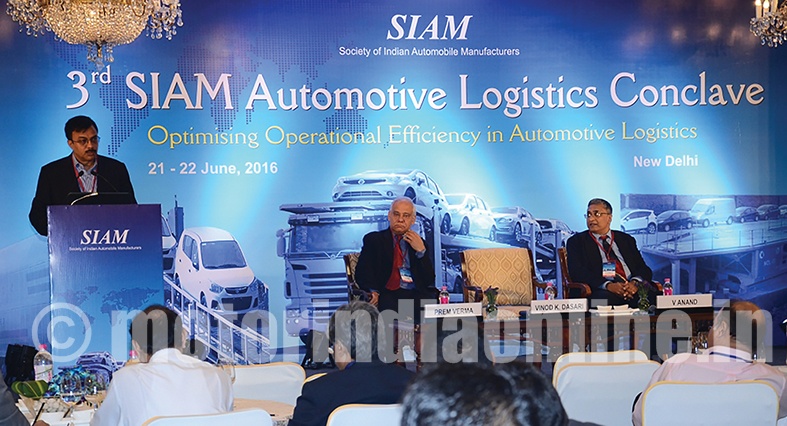The Society of Indian Automobile Manufacturers (SIAM) organised the third Automotive Logistics Conclave in New Delhi on June 21. The conference was aptly themed ‘Optimizing operational efficiency in automotive logistics’.

Speaking on the occasion, Mr. Vinod K. Dasari, SIAM President, and Managing Director, Ashok Leyland Ltd., said: “The automobile industry has been playing an important role in the economic development of the country, contributing 7.1% to the GDP. In India, the logistics cost is estimated to be around 14% of the GDP. We are keen to find out alternative ways like railways and waterways which will bring the advantage of lesser emissions and also add a safety factor.”
Road transport has played a pivotal role in the growth of India’s automotive industry. However with increased volume, alternate modes of transport become extremely critical.
Commenting on the significance of promoting other modes of transportation, Mr. Prem Verma, Chairman, SIAM Logistics Group, and Chief Executive Officer, TML Distribution Company Ltd., said: “At present more than 95% of vehicle movement in India is through road transport. With the automotive industry expected to grow at a double-digit rate in the next decade, it is imperative that the reliance on road transport should be minimized and considerable emphasis be given to other modes like railways, inland and coastal shipping.”
Mr. Bipin Menon, Director, Ministry of Commerce and Industry, observed: “Cost is one of the biggest challenges faced by the logistics industry and measures to counter it will be crucial for the growth of the sector.”
The second day of the conclave highlighted the role of Railways – Terminal, Policies & Technology for the Logistics Sector.
Railways have remained an under-used mode of transportation for finished automobiles. Less than five per cent of outbound automobile logistics is through railways. Under-developed infrastructure at terminals for storage and handling, along with non-competitive pricing, are key areas of concern in railway cargo transport.
The production and consumption patterns of automobile sector are growing in such a way that there is substantial demand for transporting automobiles from one area to another. Studies have indicated that 20 per cent of auto traffic can be carried by rail. This will enable the railways sector to earn revenue of Rs. 2,500 crores per annum through rail freight against the existing Rs. 100 crores per year.
Speaking on the occasion, Mr. UC Joshi, Executive Director (Freight Marketing), Railway Board, Ministry of Railways, said: “The Automobile Freight Transport Operator (AFTO) policy facilitates investment on procurement of auto wagons and usage of Indian railways network for meeting the transport needs of the industry. This will be a well-balanced situation for Indian Railways as well as the automobile industry / logistics provider. In terms of logistics and other requirements, Indian Railways plans to introduce smaller capacity rakes to cater to lower volumes for smaller regions. We plan to put across a system which will enable us to monitor transit time and real time tracking of the consignment.”
Commenting on the topic, Mr. H.D. Gujarati, Director, Dedicated Freight Corridor Corporation of India (DFCCIL), said: “DFC will be a game-changer in the transport and logistics sector. We are focussing on having a significant increase in the average speed of freight trains, volumetric capacity per wagon and double stack containers on the western corridor. We are in a process to introduce modern technology with will allow better maintenance, train operations with low operating cost. Dedicated freight corridor will be operational by 2020.”
The last session of the conclave was concluded with the way forward where panelists discussed the various measure taken up for operational efficiency gains through technology and manpower upgradation. Various opportunities were discussed to streamline the sector and make it cost efficient and environment friendly by opting for alternate transport routes. Infrastructure creation and capacity building will be crucial in the growth of the sector and further development of the economy.
MEDIA PARTNER: MOTORINDIA